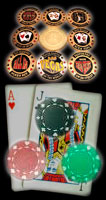PRE-FLOP IN SHORT-HANDED GAMES
I’m going to consider a short-handed game as four-handed. In a game with more players, you can usually consider it a full game, and the first few players have folded.
For example, if you’re in a six-handed game, you won’t to far wrong by just playing as if the first four players folded.
In a game with fewer than four players, the individual playing habits of your opponents become the most important consideration.
When four-handed, the first two players have blinds, the last player has the button, and the UTG players is between them.
Position is important when short-handed so the UTG player will almost always want to open with a raise.
If you get any callers, you don’t want the button to be one of them;you want only the blinds to call so that you’ll have position after the flop.
Raising is the best way to accomplish this, but the button will call with a lot of hands, so you will want to be selective when UTG, even in a short-handed game.
Short-handed. It’s struggle for the antes, a contest between a made hand and a draw, Holdem is a high-card game and a game of hand domination.
It’s a game of pairs and big cards, but it’s also a game of manipulation and pressure and a game of strategy and deception.
The particular perspective you should emphasize in a short-handed game depends on the other players in the game.
Against Tough Players
Most of the time you shouldn’t even play a game where the other players are tough, good players, but there are times when a game temporarily short-handed and you will want to keep the game going even though you’re only competing against tough players.
Only do this if you know it’s a temporary situation and that other, weak players will be showing up soon.
Against tough opponents, not only will you find it difficult to win consistently, but you’ll also tend to experience much wider than normal swings in your results.
Hand domination is the key when playing against tough players. You just need to have the best hand.
when you’re short-handed, then it sometimes doesn’t take much to have the best hand.
A 9 is often a big card in a short-handed game. A hand that has two cards, 9 or larger, is worth opening with a raise.
A single Ace often has enough high-card value on its own that it’s worth opening with a raise with any suited Ace and unsuited Aces as long as the kicker is at least about a 7 or higher.
A King doesn’t quite have the high –card value of an Ace, but suited Kings with a kicker at a 6 or higher are usually worth playing.
Some of the mid level connectors are also worth playing even though they don’t have much high-card value, for example 8 ![]() 6
6 ![]() .
.
When you’re on the button or the small blind and no one else has opened yet, you can play more aggressively.
Raising with any Ace is often correct. You might want to sometimes limp in with hands a little weaker than suggested by the table.
In a short-handed game, the second pair is often enough to win, and with hands like 7 ![]() 5
5 ![]() , it’s worth seeing the flop if you can do this, it’s a good idea to also limp with your very best hands, so that your opponents won’t start automatically raising whenever you limp.
, it’s worth seeing the flop if you can do this, it’s a good idea to also limp with your very best hands, so that your opponents won’t start automatically raising whenever you limp.
Hands that are worth limping and then reraising if raised include big pairs, 10 ![]() 10
10 ![]() and higher,and the big suited aces, a
and higher,and the big suited aces, a ![]() J
J ![]() and higher.
and higher.
If you limp and reraise with these hands and also limp with weaker hands like 8 ![]() 5
5 ![]() or 3
or 3 ![]() 3
3 ![]() , you won’t have to worry about becoming too readable.
, you won’t have to worry about becoming too readable.
Pick the Right Table / Picking a Seat / Theories of Poker / Betting Theory: The Odds
A Theory of Starting Hand Value
A Theory of Flop Play: Counting Outs and Evaluating Draws
The Dynamics of Game Conditions / Table Image / Player Stereotypes
Women and Poker / Spread-Limit Games / Double Bet on the End Games / Kill Games



